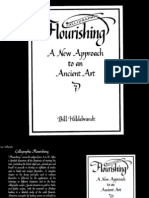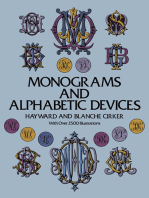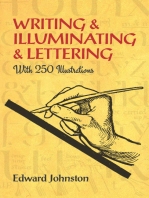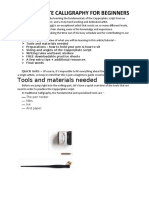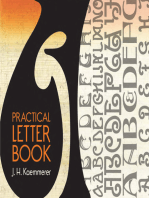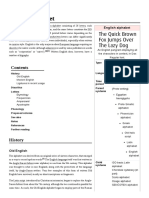0 ratings0% found this document useful (0 votes)
850 viewsGothic Lettering (Also "Blackletter", Old English Calligraphy, Etc)
Gothic Lettering (Also "Blackletter", Old English Calligraphy, Etc)
Uploaded by
Christopher EnriquezThe document provides information about different writing systems and alphabets including Gothic lettering, the Roman alphabet, Spanish orthography, and the Old English Latin alphabet. It describes key features of each such as the letters used, conventions like punctuation, and the time periods and languages they were used for.
Copyright:
© All Rights Reserved
Available Formats
Download as DOCX, PDF, TXT or read online from Scribd
Gothic Lettering (Also "Blackletter", Old English Calligraphy, Etc)
Gothic Lettering (Also "Blackletter", Old English Calligraphy, Etc)
Uploaded by
Christopher Enriquez0 ratings0% found this document useful (0 votes)
850 views1 pageThe document provides information about different writing systems and alphabets including Gothic lettering, the Roman alphabet, Spanish orthography, and the Old English Latin alphabet. It describes key features of each such as the letters used, conventions like punctuation, and the time periods and languages they were used for.
Original Description:
fonts
Original Title
Gothic Lettering
Copyright
© © All Rights Reserved
Available Formats
DOCX, PDF, TXT or read online from Scribd
Share this document
Did you find this document useful?
Is this content inappropriate?
The document provides information about different writing systems and alphabets including Gothic lettering, the Roman alphabet, Spanish orthography, and the Old English Latin alphabet. It describes key features of each such as the letters used, conventions like punctuation, and the time periods and languages they were used for.
Copyright:
© All Rights Reserved
Available Formats
Download as DOCX, PDF, TXT or read online from Scribd
Download as docx, pdf, or txt
0 ratings0% found this document useful (0 votes)
850 views1 pageGothic Lettering (Also "Blackletter", Old English Calligraphy, Etc)
Gothic Lettering (Also "Blackletter", Old English Calligraphy, Etc)
Uploaded by
Christopher EnriquezThe document provides information about different writing systems and alphabets including Gothic lettering, the Roman alphabet, Spanish orthography, and the Old English Latin alphabet. It describes key features of each such as the letters used, conventions like punctuation, and the time periods and languages they were used for.
Copyright:
© All Rights Reserved
Available Formats
Download as DOCX, PDF, TXT or read online from Scribd
Download as docx, pdf, or txt
You are on page 1of 1
Gothic Lettering (also "blackletter", Old
English calligraphy, etc)
To jump straight into doing Gothic
lettering, go to the Gothic alphabet tutorial
pages.Or read on for more information and
links about the different varieties, uses and
history of Gothic script.
The Roman alphabet, also called the Latin
alphabet, is the most widely used alphabet
in the world. You’re reading it right now.
The Roman alphabet has two different forms
of each letter: the minuscule or lower-case
form ...
abcdefghijklmnopqrstuvw
xyz
Spanish orthography is the orthography used
in the Spanish language. The alphabet uses
the Latin script. The spelling is fairly phonemic,
especially in comparison to more opaque
orthographies like English and Irish, having a
relatively consistent mapping
of graphemes to phonemes; in other words, the
pronunciation of a given Spanish-language word
can largely be predicted from its spelling and to
a slightly lesser extent vice-versa. Notable
features of Spanish punctuation include the lack
of the serial comma and the inverted question marks and exclamation points: ¿ ¡.
The Old English Latin alphabet—though it had
no standard orthography—generally consisted of
24 letters, and was used for writing Old
English from the 9th to the 12th centuries. Of
these letters, 20 were directly adopted from
the Latin alphabet, two were modified Latin letters
(Æ, Ð), and two developed from the runic
alphabet (Ƿ, Þ). The letters K, Q and Z were not in
the spelling of native English words.
You might also like
- Calligraphic Flourishing - Bill HildebrandtDocument66 pagesCalligraphic Flourishing - Bill HildebrandtCaeledriss88% (32)
- Speedball Text BookDocument99 pagesSpeedball Text BookLucas Leite100% (4)
- Estonian Calligraphy 1940 - 1970Document300 pagesEstonian Calligraphy 1940 - 1970Liza Bowman100% (19)
- Almost Complete Selection of Speedball CoversDocument8 pagesAlmost Complete Selection of Speedball CoversTed Haigh100% (7)
- The Art of Hand-Lettering: Techniques for Mastery and PracticeFrom EverandThe Art of Hand-Lettering: Techniques for Mastery and PracticeRating: 5 out of 5 stars5/5 (1)
- Deed of Sale of MotorcycleDocument6 pagesDeed of Sale of MotorcycleChristopher Enriquez63% (8)
- MathWorks Interview ProcessDocument2 pagesMathWorks Interview ProcessPawan Singh100% (1)
- CalligraphyDocument12 pagesCalligraphyKapil SinghNo ratings yet
- Gothic ManualDocument20 pagesGothic ManualCesare Falzoni100% (3)
- Speedball ChartDocument28 pagesSpeedball ChartMicheleNo ratings yet
- CaligraphyDocument20 pagesCaligraphydahakumiNo ratings yet
- Caligraphy SamplesDocument11 pagesCaligraphy SamplesMigue VIs100% (3)
- Speedball Nib GuideDocument12 pagesSpeedball Nib Guideapi-25924235780% (5)
- Hand Lettering Guide Lines A4 PDFDocument1 pageHand Lettering Guide Lines A4 PDFrandi0% (1)
- The Vintage Speedball TextbookDocument1 pageThe Vintage Speedball TextbookJuzef StaljinNo ratings yet
- Copperplate Script GridsDocument6 pagesCopperplate Script GridsKeith Zyrel Buccat0% (2)
- Italic and Copperplate Calligraphy: The Basics and BeyondFrom EverandItalic and Copperplate Calligraphy: The Basics and BeyondRating: 4 out of 5 stars4/5 (11)
- Pte Prep Tips-Compiled From Expat ForumDocument12 pagesPte Prep Tips-Compiled From Expat ForumRaja TouseefNo ratings yet
- Hitomi Kanehara Snakes and Earrings Penguin 2005 PDFDocument87 pagesHitomi Kanehara Snakes and Earrings Penguin 2005 PDFLili Ana100% (2)
- The Uses of Italic A Primer of Information Regarding the Origin and Uses of Italic LettersFrom EverandThe Uses of Italic A Primer of Information Regarding the Origin and Uses of Italic LettersNo ratings yet
- 1 - Book of Ornamental Aplhabets PDFDocument59 pages1 - Book of Ornamental Aplhabets PDFGiovany Ladino100% (3)
- MasterBlackletterV0 Comp SecuredDocument151 pagesMasterBlackletterV0 Comp SecuredMatthew100% (2)
- Lettering: Design & Drafting Technology Unit 7Document14 pagesLettering: Design & Drafting Technology Unit 7Ryan CalicaNo ratings yet
- Bain Learningfromscript Designerscornerhsv 2017 PDFDocument10 pagesBain Learningfromscript Designerscornerhsv 2017 PDFVíctor M GonzálezNo ratings yet
- Modern Calligraphy Practice Sheet LowercaseDocument2 pagesModern Calligraphy Practice Sheet LowercaseFortino Barragan100% (1)
- Gothic Black LetterDocument3 pagesGothic Black Lettermichaelguzzi100% (1)
- Theory and Practice Lettering U31924021896877Document92 pagesTheory and Practice Lettering U31924021896877raftz292121100% (14)
- New Spencer Ian CompendiumDocument176 pagesNew Spencer Ian Compendiumhysleken100% (2)
- Lettering by Thomas Wood StevensDocument128 pagesLettering by Thomas Wood StevensAdriana Fajardo100% (3)
- (Jones, C W, Editor) Lessons in Engraver's ScriptDocument18 pages(Jones, C W, Editor) Lessons in Engraver's ScriptCereal69No ratings yet
- Lettering 2 StudioDocument294 pagesLettering 2 StudioGen O.No ratings yet
- Elements of Lettering and Sign PaintingDocument162 pagesElements of Lettering and Sign PaintingiMiklae100% (8)
- Modern Calligraphy Practice Sheets DawnNicoleDesigns PDFDocument6 pagesModern Calligraphy Practice Sheets DawnNicoleDesigns PDFEmanuel Carlos100% (2)
- Gothic AlphabetDocument43 pagesGothic Alphabetokksekk100% (1)
- 1 - Practical Chancery Cursive (Italic) Writing - IntroductionDocument6 pages1 - Practical Chancery Cursive (Italic) Writing - Introductionv222v2No ratings yet
- The Speedball Pen and The Lettering Artist: by Randall M. HassonDocument6 pagesThe Speedball Pen and The Lettering Artist: by Randall M. HassonYessica Vargas100% (2)
- How To Use These Guidesheets: X-Height SpaceDocument7 pagesHow To Use These Guidesheets: X-Height Spacespringrose983917No ratings yet
- Copperplate Calligraphy For BeginnersDocument10 pagesCopperplate Calligraphy For BeginnersVy NguyễnNo ratings yet
- Calligraphy Letters FormalDocument26 pagesCalligraphy Letters Formalglyn2274No ratings yet
- Lupfer 1933 - Zaner's Fundamental Letter Forms A To Z - TEDocument10 pagesLupfer 1933 - Zaner's Fundamental Letter Forms A To Z - TEAna Larisa Gheorghe100% (1)
- Writing and Calligraphy BooksDocument31 pagesWriting and Calligraphy BooksSteve Ruiz83% (6)
- Blackletter PDFDocument5 pagesBlackletter PDFviolita ayuNo ratings yet
- Zaner - Lessons in Ornamental PenmanshipDocument48 pagesZaner - Lessons in Ornamental PenmanshipMarko Nišić100% (2)
- Western CalligraphyDocument16 pagesWestern Calligraphydhivyais57% (7)
- CalligraphyDocument20 pagesCalligraphyCha Deleonio50% (4)
- Manuscript Product Brochure 2013Document28 pagesManuscript Product Brochure 2013manuscriptpNo ratings yet
- Adorn Users GuideDocument154 pagesAdorn Users GuideGioya100% (3)
- A Textbook On Lettering and Sign Painting 1902Document384 pagesA Textbook On Lettering and Sign Painting 1902masterviking100% (9)
- Paul Antonio Scribe - Style Sheet - Without PricingDocument34 pagesPaul Antonio Scribe - Style Sheet - Without PricingLoredana AnghelNo ratings yet
- Calligraphy BookDocument102 pagesCalligraphy Bookgeana100% (6)
- Calligraphy Manual in Easy Steps UnknownDocument68 pagesCalligraphy Manual in Easy Steps UnknownNyannn100% (4)
- The Book of Ornamental Alphabets, Ancient and Medieval, from the Eighth Century With Numerals, including Gothic; Church Text, Large and Small; German Arabesque; Initials for Illumination, Monograms, Crosses, &c.From EverandThe Book of Ornamental Alphabets, Ancient and Medieval, from the Eighth Century With Numerals, including Gothic; Church Text, Large and Small; German Arabesque; Initials for Illumination, Monograms, Crosses, &c.Rating: 5 out of 5 stars5/5 (2)
- Letters and Lettering A Treatise With 200 ExamplesFrom EverandLetters and Lettering A Treatise With 200 ExamplesRating: 3 out of 5 stars3/5 (1)
- 850 Calligraphic Ornaments for Designers and CraftsmenFrom Everand850 Calligraphic Ornaments for Designers and CraftsmenRating: 4.5 out of 5 stars4.5/5 (6)
- English AlphabetDocument7 pagesEnglish AlphabetSushila SuriNo ratings yet
- Alphabet of LineDocument3 pagesAlphabet of LineChristopher EnriquezNo ratings yet
- The Types of CloudsDocument7 pagesThe Types of CloudsChristopher Enriquez100% (1)
- GroupDocument1 pageGroupChristopher EnriquezNo ratings yet
- Malabar Night Shade Asparagus Cow Pea Chick PeaDocument1 pageMalabar Night Shade Asparagus Cow Pea Chick PeaChristopher EnriquezNo ratings yet
- DeedDocument6 pagesDeedChristopher EnriquezNo ratings yet
- Volcanic Eruption: Geothermal EnergyDocument2 pagesVolcanic Eruption: Geothermal EnergyChristopher EnriquezNo ratings yet
- Emphasis MarkersDocument9 pagesEmphasis MarkersChristopher Enriquez70% (10)
- Research PaperDocument11 pagesResearch PaperChristopher EnriquezNo ratings yet
- ArtifactsDocument6 pagesArtifactsChristopher EnriquezNo ratings yet
- AYUPITDocument4 pagesAYUPITChristopher EnriquezNo ratings yet
- Causes of Malnutrition Among Grade 7 Students inDocument4 pagesCauses of Malnutrition Among Grade 7 Students inChristopher Enriquez100% (1)
- Legend of The First MonkeyDocument4 pagesLegend of The First MonkeyChristopher EnriquezNo ratings yet
- Fitness: Components of Physical FitnessDocument3 pagesFitness: Components of Physical FitnessChristopher Enriquez100% (1)
- Cuts of BeefDocument4 pagesCuts of BeefChristopher EnriquezNo ratings yet
- Roan Jane M. Berjuega G7Document4 pagesRoan Jane M. Berjuega G7Christopher EnriquezNo ratings yet
- Fits The BoxDocument9 pagesFits The BoxChristopher EnriquezNo ratings yet
- Ballroom DanceDocument4 pagesBallroom DanceChristopher EnriquezNo ratings yet
- Approaches To TeachingDocument11 pagesApproaches To TeachingChristopher EnriquezNo ratings yet
- DressDocument1 pageDressChristopher EnriquezNo ratings yet
- Unid SIXDocument15 pagesUnid SIXWilly D. CastroNo ratings yet
- Crash Course On Tensorflow!: Vincent Lepetit!Document63 pagesCrash Course On Tensorflow!: Vincent Lepetit!Akshay ChellsNo ratings yet
- Uale2013/Mpu32023 English For Business Interpretation of Graphical Data (Vocabulary)Document28 pagesUale2013/Mpu32023 English For Business Interpretation of Graphical Data (Vocabulary)Hao Cheng SekNo ratings yet
- Admission Form All 2019 1Document8 pagesAdmission Form All 2019 1Riz WanNo ratings yet
- English LanguageDocument3 pagesEnglish LanguageTrue SkateNo ratings yet
- PT 3 - 10TH - Datesheet & SyllabusDocument1 pagePT 3 - 10TH - Datesheet & SyllabusMr. TyperNo ratings yet
- AmharicDocument2 pagesAmharicRinnah TeklayNo ratings yet
- The Documented Essay On A ConceptDocument25 pagesThe Documented Essay On A ConceptMarlyn Garcia100% (4)
- Amazing Facts About India and IndiansDocument8 pagesAmazing Facts About India and Indiansakchourasia709No ratings yet
- Judul AbstractDocument12 pagesJudul AbstractIzoelD'zoelzNo ratings yet
- Subject Wise Property of CurriculumDocument11 pagesSubject Wise Property of Curriculumpk6112402No ratings yet
- Hungarian Grammar: C. Arthur & Ilona GineverDocument117 pagesHungarian Grammar: C. Arthur & Ilona GineverManó Kinga Horváth100% (2)
- 9th English Super Guess The Hope23Document30 pages9th English Super Guess The Hope23Tariq Walayat67% (3)
- Journal 2 Essay Editing ChecklistDocument1 pageJournal 2 Essay Editing ChecklistTerry FurgasonNo ratings yet
- Analogy: .-Rgy - TnshipDocument10 pagesAnalogy: .-Rgy - Tnshipamol86vnitNo ratings yet
- Full Speed Python PDFDocument39 pagesFull Speed Python PDFShiva ShankarNo ratings yet
- Glossary - Module 1 (1) TEFLDocument26 pagesGlossary - Module 1 (1) TEFLAnum hanifNo ratings yet
- All About #3 Painless Filipino Grammar: Lesson NotesDocument3 pagesAll About #3 Painless Filipino Grammar: Lesson NotesPeter shaan100% (1)
- Chinese and Sumerian Grammar and DictionaryDocument198 pagesChinese and Sumerian Grammar and Dictionarymaghon100% (8)
- Key Answers - English Language (KISA)Document6 pagesKey Answers - English Language (KISA)sprateekkumar42No ratings yet
- The Prince and The Pauper Mandarin Companion Level 1 SAMPLEDocument56 pagesThe Prince and The Pauper Mandarin Companion Level 1 SAMPLEAbdul Jalil100% (1)
- AdjectivesDocument11 pagesAdjectivesAnastasiya TokarNo ratings yet
- Austin's 'Sense and Sensibilia'Document12 pagesAustin's 'Sense and Sensibilia'es2344No ratings yet
- HY200A DIBt ETA-11 0493Document42 pagesHY200A DIBt ETA-11 0493mircea_pNo ratings yet
- Emelianov Vladimir - The Identity of Gudea As A Cultural and Historical ProblemDocument14 pagesEmelianov Vladimir - The Identity of Gudea As A Cultural and Historical ProblemNikola Pacek-VetnićNo ratings yet
- Week 1Document6 pagesWeek 1LARRY FABINo ratings yet
- Kunci Pathway Program Peminatan BaruDocument74 pagesKunci Pathway Program Peminatan BaruMelinaNo ratings yet
